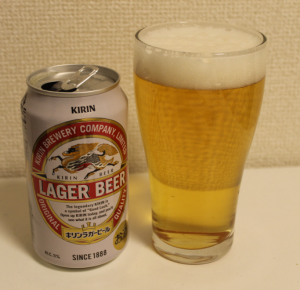
Japanese: キリンクラシックラガー (KIRIN KURASIKKU RAGER)
Brewery: Kirin
Style: Lager
ABV: 4.5%
Price: 207円
Strapline: “A time-honored recipe that delivers a rich, full-bodied lager”
Sometimes, in Japan, archetypal products are valued beyond the properties they possess in themselves. There is a gentleman who runs a new, but very excellent British pub in the centre of Osaka. He told me that the variety on the menu is mostly for the benefit of expats, since the Japanese who come in will inevitably order Fish and Chips. Of course it could be that the humble fillet of battered white fish and its accompaniment of chips, peas and palpitations fulfills some unrecognized longing in the Japanese psyche – except that it’s not just fish and chips that this applies to. It’s pictures, routines, turns of phrase – a mountain of trivial things.
Of course Brits (and probably people in every country) do this too –
“A British pub? Well I’ve just got to have fish and chips!”
“A curry house? Well I’ve just got to have a chicken tikka masala!” (Alternatively: “Well I’ve just got to have a phall”)
And thus we begin, Japanese style, with the archetypal Kirin Classic. The dirty, off-white colour scheme of the can and the style of the writing suggest a long history. Somewhat surprisingly this does turn out to be the case – Kirin is over a hundred years old. The handsome fellow at the top is in fact a kirin, a creature of East Asian mythology. Imagine a magical, scaly dog-unicorn. Yep.
Just as I can’t dispute “time-honored”, it’s also fair to call this a “rich, full bodied lager”. It’s not too malty, but also not too sweet or gassy. Given the American influence on Japanese culture since the war, one almost expects to be buying Budweiser-with-a-dragon-on-the-front, but in fact the taste has more in common with true German lagers.
I’d like to believe that the recipe really hasn’t changed since 1888. It’s really not a bad beer. In fact, part of the reason for beginning with it is that it stands (alongside its Sapporo, Suntory and Asahi counterparts) as a good yardstick against which to measure the other convenience store offerings. Good head retention and a pleasing flavour. Strangely for a lager, it tastes like it ought to cause a terrible blocked-neurone hangover – but of course it doesn’t. I will drink this again, though perhaps it won’t be my regular beer.









